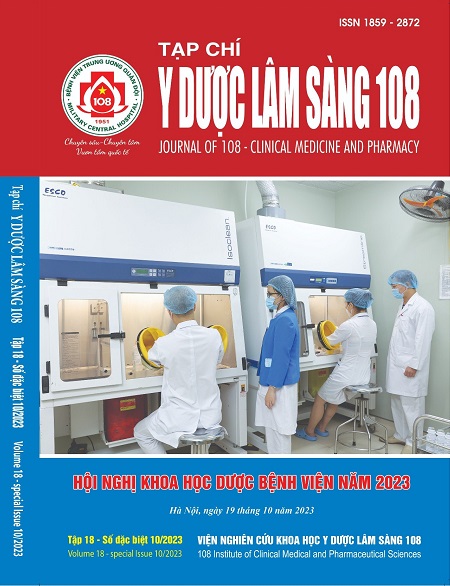Survey on use of vancomycin at National Lung Hospital in 2021
Main Article Content
Keywords
Abstract
Objective: To describe the usage characteristics and nephrotoxicity of vancomycin. Subject and method: This retrospective study in inpatients treated with vancomycin at the National Lung Hospital between 01/1/2021 and 30/6/2021. Result: Out of 74 patients, 73% of patients had improved outcomes at discharge when treated with vancomycin. The median duration of vancomycin use was 10 (5-15) days. Loading dose regimen was applied in 54% of patients, ranging from 20-40mg/kg, the common maintenance dose was 1g/12h. 85% of patients are monitored renal function 1-3 times/week. Creatinine levels tended to increase after 10 days of treatment. The rate of patients experiencing nephrotoxicity was 10.8%, with 5.4% of patients at level R - risk, 1.3% of patients at level I - Injury and 4.1% of patients at level F-failure. Among patients with nephrotoxicity: 75% of patients had risk factors such as concomitant use of nephrotoxic drugs or were elderly, 80% of patients were administered vancomycin for more than 10 days. Conclusion: Vancomycin is an antibiotics that need to be managed and monitored when using. The prevalence of about 10% nephrotoxicity shows that it is necessary to develop guidelines for vancomycin use in our hospital, which include the implementation of therapeutic drug monitoring to control effective concentration and adverse event, especially nephrotoxicity.
Article Details
References
2. Lê Vân Anh, Lương Thúy Lan, Hoàng Thị Kim Huyền (2013) Khảo sát thực trạng sử dụng vancomycin tại Bệnh viện Bạch Mai. Tạp chí dược học, 451, tr. 6-11.
3. Lưu Thị Thu Trang (2020) Phân tích đặc điểm sử dụng vancomycin trong điều trị nhiễm khuẩn huyết tại trung tâm bệnh nhiệt đới, Bệnh viện Bạch Mai. Khóa luận tốt nghiệp dược sĩ, Trường Đại học Dược HN.
4. Nguyễn Hoàng Anh (b), Nguyễn Thị Mai Anh, Vũ Đình Hòa và cộng sự (2020) Phân tích thực trạng sử dụng vancomycin ở bệnh nhân điều trị tại Khoa Hồi sức tích cực, Bệnh viện Thanh Nhàn. Tạp chí dược học, 528, tr. 10-14.
5. Filippone EJ, Kraft WK et al (2017) The nephrotoxicity of vancomycin. Clin Pharmacol Ther 102(3): 459-469.
6. Linden PK (2007) Optimizing therapy for vancomycin-resistant entercococci. Semin Respir Crit Care Med 28(6): 632-645
7. Rybak M, Lomaestro B et al (2009) Therapeutic monitoring of vancomycin in adult patients: A consensus review of the American Society of Health-System Pharmacists, the Infectious Diseases Society of America, and the Society of Infectious Diseases Pharmacists. Am J Health Syst Pharm 66(1): 82-98.
8. Rybak MJ, Le J, Lodise TP, Levine DP, Bradley JS, Liu C, Mueller BA, Pai MP, Wong-Beringer A, Rotschafer JC, Rodvold KA, Maples HD & Lomaestro BM (2020) Therapeutic monitoring of vancomycin for serious methicillin-resistant Staphylococcus aureus infections: A revised consensus guideline and review by the American Society of Health-System Pharmacists, the Infectious Diseases Society of America, the Pediatric Infectious Diseases Society, and the Society of Infectious Diseases Pharmacists. American journal of health-system pharmacy: AJHP: Official journal of the American Society of Health-System Pharmacists 77(11): 835-864.
9. Thadhani R et al (1996) Acute renal failure. New England Journal of Medicine 334 (22): 1448-1460
 ISSN: 1859 - 2872
ISSN: 1859 - 2872
